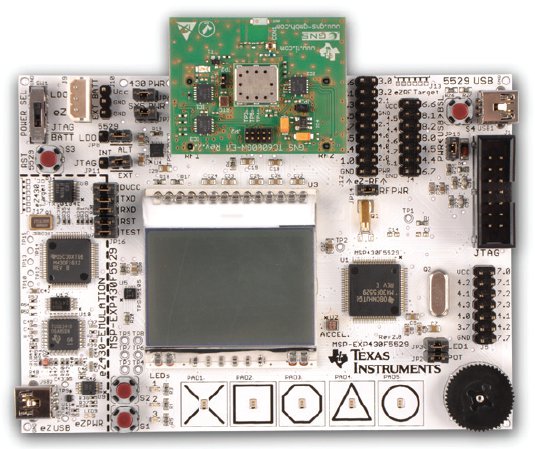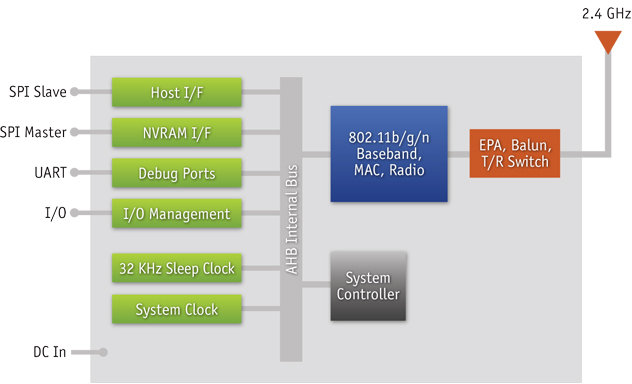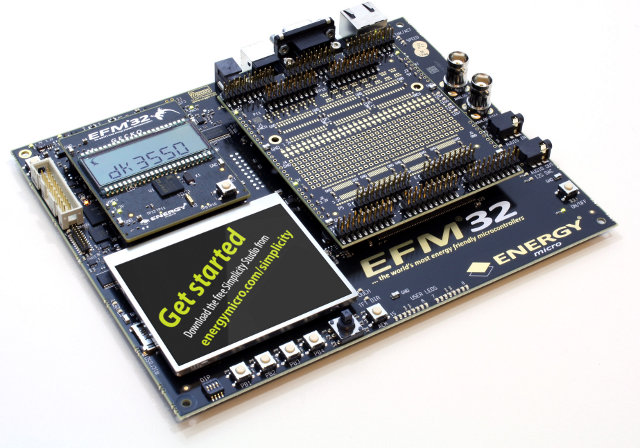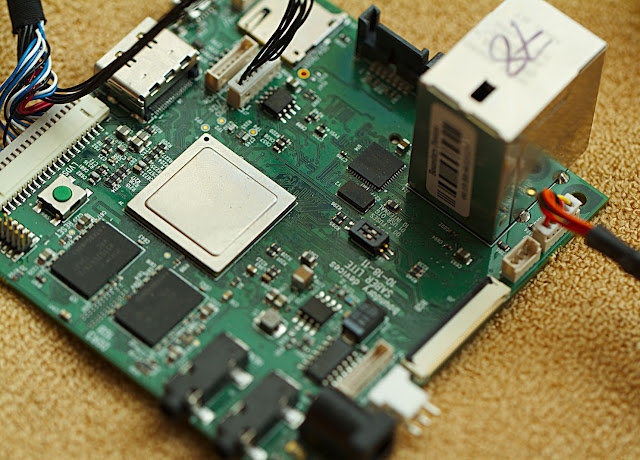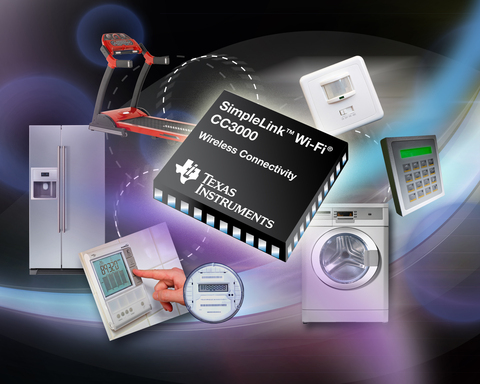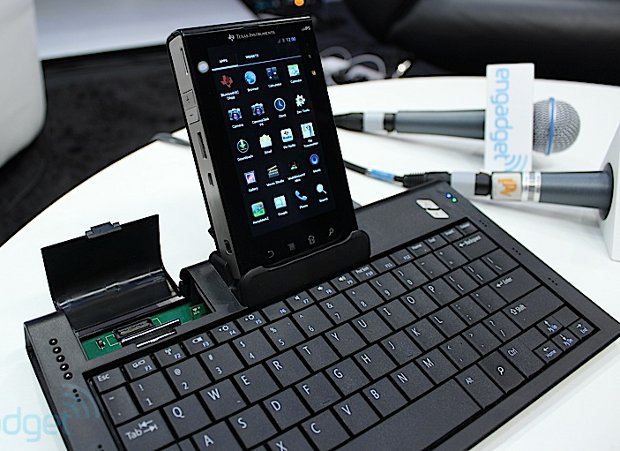Yesterday, Texas Instruments unveiled the SimpleLink GPS CC4000, a GPS self-contained module that can be interfaced with any MCU or MPU having a UART interface. Due to limited resources of microcontrollers, several GPS features have been implemented in hardware such as the push-to-fix function which can simply be controlled by the MCU via a GPIO to receive National Marena Electronics Association (NMEA) strings containing location, time and velocity information. TI Simplelink GPS CC4000 enables GPS-based applications such as asset tracking, industrial M2M, sports and fitness, and precision timing. It can deliver better than 2.5 meter accuracy and provides pulse-per-second output functions to provide precise location and timing data. It can also automatically reuse previously decoded satellite information thanks to its “watchful-eye” feature in order to deliver fast time to first fix (TTFF) and optimize power consumption. Here are SimpleLink GPS CC4000 key features: Driverless, fully integrated GPS solution which requires […]
Qualcomm Atheros AR4100P Provides WiFi Connectivity to the Internet of Things
In January, Texas Instruments was the first company (to my knowledge) to release a WiFi chip for the internet of things, the SimpleLink Wi-Fi CC3000, where WiFi is mostly implemented in hardware to lower power consumption. Now, the company has some competition with the announcement of Qualcomm Atheros AR4100P, an improved version of its AP4100 WiFi chipset, including IPv4/IPv6 support. The AR4100 targets the home, enterprise, smart grid and home automation and control applications that have lower data rates and transmit or receive data on an infrequent basis. The AR4100 system-in-package (SIP) features the following: Low energy Power saving modes as low as 5 µA Wake-up times as low as 2.2 ms Support for Quad SPI flash for faster wake times Low system resource requirements Low footprint host driver (25K Flash and 8K RAM) Simple, low-cost wireless system integration LGA package simplifies 2- or 4-layer PCB design Near zero RBOM […]
Energy Micro Announces EFM32G-DK3550 Gecko (Cortex-M3) Development Kit
Energy Micro has just announced the availability of the EFM32G-DK3550 development kit based on ARM Cortex-M3 EFM32G890F128 MCU. The kit (pictured below) is based on the main board from the bigger Leopard and Giant Gecko kits and supports SEGGER J-Trace and J-Link in order to reduce the need for additional debugging tools. Here are the development kit specifications: EFM32G890F128 Gecko Cortex-M3 MCU 4MB PSRAM 16MB NOR-Flash 320 x 240 RGB resistive touch TFT display Ethernet MAC/PHY microSD slot audio I/O and I2S DAC USB debug interface, SEGGER J-Link debugger Advanced Energy Monitoring (AEM) system to monitor the prototype’s energy consumption. 2x RS232, IrDA Switches, Joystick, LEDs, potentiometer… EXP32 Prototyping area (right side of the picture) For software development, Energy Micro provides Simplicity Studio suite, which includes energyAware Profiler that can interface with the AEM system via USB, gather all relevant system data, and display real-time graphs of current consumption on a […]
Low Cost Freescale iMX6 Quad Sabre Lite Development Board
i.MX6q SABRE Lite Board is a low-cost development platform based on Freescale Quad Core Cortex A9 i.MX 6Quad Application Processor. This will probably be the first low cost ARM quad-core development board to hit the market. Nvidia has previously announced the CARMA Tegra 3 CUDA Development Kit, but the price has not been announced and when I look at the picture of the board and the specs, “low cost” does not come to mind. Here are the technical specifications for the Sabre Lite board: Quad-Core ARM® Cortex A9 processor at 1GHz per core 1GB DDR3 @ 532MHz 3 display ports (RGB, LVDS, and HDMI 1.4a) Two camera ports (1xParallel, 1x MIPI CSI-2) Multi-stream-capable HD video engine delivering H.264 1080p60 decode,1080p30 encode and 3-D video playback in HD Triple Play Graphics system consisting of a Quad-shader 3D unit, and a separate 2-D and separate OpenVG Vertex acceleration engine for superior 3D, […]
Atollic TrueSTUDIO for ARM 3.0 To Be Released at Embedded World 2012
Atollic has just announced that Atollic TrueSTUDIO for ARM 3.0 – a C/C++ development tool for embedded developers – will be released on the 28th of February 2012, at Embedded World 2012, Nuremberg, Germany. Atollic TrueSTUDIO v3.0 will bring the following improvements: Redesigned user interface that is more intuitive to C/C++ developers New support for NXP LPC1000 Cortex-M0 and Cortex-M3 devices New support for Infineon XMC4000 Cortex-M4 devices New support for Energy Micro EFM32 (Cortex-M3) Upgraded support for STMicroelectronics STM32 devices Improved real-time interrupt tracing with ARM Serial Wire Viewer (SWV) interface. Execution time profiling now present information using bar charts Upgraded ECLIPSE platform to the latest “Indigo” release (3.7.1) Major upgrade of the GNU command line tools Upgraded TrueINSPECTOR, TrueANALYZER and TrueVERIFIER add-on products Supports over 800 ARM devices Hundreds of minor improvements Since the product has not been released, that’s currently all information there is. Further information will certainly […]
TI SimpleLink Wi-Fi CC3000 Brings WiFi Connectivity to All Devices
Yesterday, Texas Instruments unveiled the SimpleLink product family, a portfolio of wireless connectivity technologies for low-power, low-cost embedded applications, which includes self-contained wireless processors supporting Wi-Fi, ZigBee, 6LoWPAN, and ANT. The most noticeable product is the SimpleLink Wi-Fi CC3000, a self-contained 802.11 (WiFi) network processor, that can be added to any embedded application and provide WiFi connectivity to the Internet of Things. With this solution, you can add WiFi to any device, even those powered by MCUs without operating systems such as dishwashers, toasters, refrigerators, thermostats, and factory automation equipment. I wish they’ll make new version of the MSP430 Chronos Wireless Watch with WiFi connectivity, this would remove the need for the RF Dongle. This solution features TCP, UDP and IP software stacks in the chip, it consumes 0.5% of the resources as compared to traditional Wi-Fi and only requires 6KB Flash and 3KB RAM. The company claims it can be […]
Texas Instruments OMAP 5 Reference Design
Texas Instruments announced it was developing the OMAP 5, the first Cortex A15 processor, in February 2012. This year at CES 2012, Texas Instruments unveiled OMAP 5-based reference design / development platform running Android 4.0.1 to Engadget. Remi El-Ouazzane, VP of OMAP at Texas Instruments, explains: “This is the greatest platform on Earth right now… way ahead of Apple, and it’s the first Cortex-A15 (which runs 2x faster than the Cortex-A9) product on the market. When running two Cortex-A15 chips at 800MHz, it’s more or less the same performance as running two Cortex-A9s at 1.5GHz. You’ll see [commercially available products] ramping up with this stuff in late 2012 or early 2013. We are also running Windows 8 on the latest OMAP; it runs perfectly well, and we’ve been working very closely with Microsoft. We’re working on multiple form factors — tablets, thin-and-lights — and we think ARM is going to […]
MIPS Releases Android NDK 7m
MIPS has just announced the release of the Android Native Development Kit version 7. It has the same APIs as the Android NDK revision 7 released in November 2011 (for Android 4.0), but adds support for MIPS architecture and the MIPS ABI . The NDK is available for Windows, Linux and MacOS. The NDK allows developers to use C/C++ code either to reuse existing C/C++ code or to improve the performance over code developed with Java. Note that MIPS states that “using native code does not result in an automatic performance increase, but always increases application complexity. If you have not run into any limitations using the Android framework APIs, you probably do not need the NDK.” The NDK can be downloaded for: Windows Linux Mac You’ll also have to download the Android MIPS SDK, if you want to use the NDK. Strangely, the Mac SDK is not available for […]


